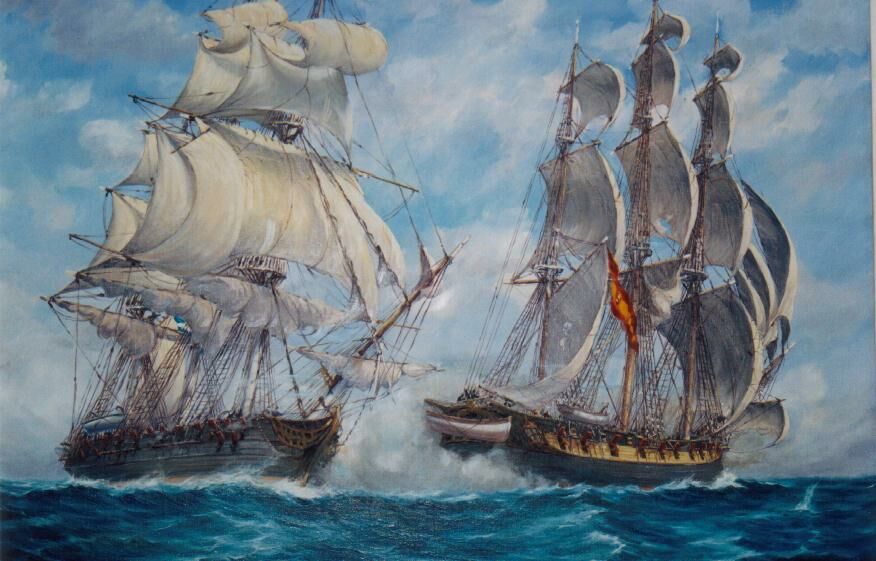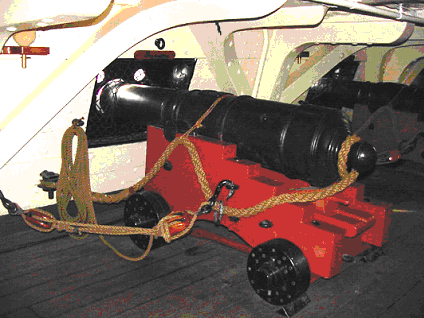
The Black Frigate By Eduardo C. Gerding* Published by the Buenos Aires Herald 'Sunday-History' (24 October 2004) |
||||
 Admiral Brown's frigate Hercules and the Spanish Gobernadora. Oil painting by Emilio Biggeri, 1966. (Museo Naval de la Nación, Tigre) |
||||
The Origin The origin of Argentine navy's first flagship has been a controversial issue and a motive for sharp remarks among well known historians. According to a Memorandum presented on 5 August 1817 by Lieutenant Colonel William Brown to the Lords of His Majesty Treasure, the Hercules had Russian origins. Brown confirmed such origin again in 1855 in a document requested by General Bartolomé Mitre which was translated into Spanish by General Tomás Guido. The Times of London dated 21 December 1818 and 7 April 1819 published an official statement made by the Admiralty Court which began with this revealing statement: 'In the case of the ship Hercules, otherwise the Duke of Palma ...'. Whatever could have been the Duke of Palma's history it still waits to be revealed. According to Sergei Klimovsky, Scientific Secretary of the Russian Central Naval Museum, the main Russian shipyards where such frigate could have been built in the 1800s were: Okhta Admiralty, Saint Petersburg and Arkhangelsk Admiralty, Arkhangelsk, White Sea. The vessels which could have been the Duke of Palma during her service in the Russian Navy probably were: 44-guns frigate Speshny (1800), Arkhangelsk, captured by the English on 20 September 1807 in Portsmouth; 38-guns frigate Legky (1800), Arkhangelsk passed to France on 27 September 1809; 60-guns ship-of-the line Finland, captured in 1790 from Sweden and sold in 1813 to England; 64-guns ship-of-the line Retvizan, captured in 1790 from Sweden and sold in 1813 to England.
In December 1813, the Minister of War
Juan Larrea signed an agreement with Boston-born Guillermo Pío
White (Pedro Lezica's partner), by which the latter was to provide
the means for a naval squad that could ensure success against the
Spanish naval forces. |
||||
|
||||
John Goodfellow sold the Hercules, her cargo (ninety tons of salt and sixty tons of charcoal), as well as her Russian papers, by $25,000 of which $12,500 were paid cash and the rest through a credit of $12,500 from the custom house. Most likely, the Hercules arrived in Buenos Aires in about 1813 although there are no documents availing this. On 4 January 1814 The first ship was officially incorporated to the navy under the command of Eliseo Smith. |
||||
|
||||
|
A land attack was organized and at that moment William Brown ordered the fife and the drum to play 'Saint Patrick’s Day in the Morning', which acted as a real booster among the troops. On 20 April 1814 Montevideo was blocked by Argentine forces. There were no other major engagements until 14 May, when a combat started but the sea conditions stopped a full attack.
On 16 May 1814 the Hercules, the Belfast, the Zephir and the small coasting schooner Itatí, backboned by the Agreeable, engaged in fight with the Spanish warships Neptuno, San José and La Paloma in front of Buceo. On 17 May, during the persecution, Admiral Brown received a cannon shot which broke one of his legs. The Spanish warship Maria was seized and brought to Buenos Aires just like Neptuno, Paloma and San José. The Mercurio was chased up to the very port of Montevideo. By June 1814 the Spanish crown had lost Montevideo. The Hercules returned to Buenos Aires leaving Captain Russell to command the blockade of Montevideo. On 23 June 1814 Montevideo surrendered as well as the whole Spanish squad. On August 1814, the Argentine fleet was auctioned but the Hercules was bestowed to Admiral Brown by the government of United Provinces of the Rio de la Plata. The frigate was then lined up with copper and armed with twenty-nine cannons of twenty-four, twelve and eight pounds. The letter of marque was issued on 1 September 1815. She departed from Buenos Aires on 15 September 1815 commanded by Michael Brown, since William Brown was not to get involved in privateer actions. Notwithstanding, once in the River Plate William Brown took the command, his second in chief being David Chitty. Michael Brown took command of the Trinidad. The Hercules navigated around Cape Horn and in front of Chiloé the Argentines seized the schooner Mercedes. Later, in front of Morro Quemado, they captured the frigate Gobernadora, which was sailing from Guayaquil to Lima. On 16 January 1816 the brig San Pablo was captured and became Brown’s hospital ship. On 18 January, they captured a pilot’s boat and the following day, a místico (small coasting vessel) that was sailing from Pisco was sunk. On 20 January the Argentine naval forces arrived to Callao and, on 21 January they started bombarding the castles of Rimac. During twenty days the biggest Spanish stronghold was blocked by five ships waving the flag of Buenos Aires. On 21 January the frigate Fuente Hermosa was sunk. On 23 January, after a fierce combat, the frigate Consecuencia was captured when sailing from Cadiz. Among the passengers was brigadier Juan M. Mendiburu. The Consecuencia became later La Argentina, which was to be commanded by French naval officer Hipólito Bouchard. On 25 January the warship La Candelaria was captured. 1816 - The Attack to Guayaquil On 29 January 1816 Admiral Brown set sail in the Trinidad for Guayaquil, and on 18 February he attacked the batteries of Punta Piedras, which he captured after a long struggle. Brown captured the schooner Carmen and attacked the battery Elizalde. Then he attacked de San Carlos castle but the Trinidad got stranded as a consequence of the quick ebb of the Guayas river. As a result of this, Brown was captured by the Spanish forces but was rescued by the gallant action of the Consecuencia and the Hercules. Miguel Brown and Chitty took part in the exchange of prisoners. Our forces released the Spanish prisoners and their mail and set free the Candelaria, the Gobernadora, a mistico and two small vessels. The Trinidad was lost and William Brown returned to the Hercules. Scurvy Aboard The Hercules set sails to the Galapagos islands where the prizes were shared out. Admiral Brown obtained the Halcon and Bouchard the Consecuencia, the pilot’s boat Carmen went to Pedro Dautant. The Hercules and the Halcon navigated then to Colombia in a painful journey as most of the crew was suffering of scurvy. A fifty-five men crew departed on June 1816 from San Buenaventura, visited the Isle of Pascua and then sailed around Cape Horn. They had to feed themselves mostly of turtle, maize and rum. The cargo was lightened in the Gulf of Penas and then they set sailed to the Falkland/Malvinas Islands. A maelstrom forced them to stop in Brazil near the Cabo Frío. In this last place they met the British brig Jane, which updated them on the last political news at the River Plate. Trouble in Barbados On 25 September 1818, William Brown, following his officer’s advice entered in Carlisle Bay near Barbuda, located in the middle of the Leeward Islands in the Eastern Caribbean. According to the Gentleman’s Magazine (1816, Vol. 11, p. 552) and the Times (22 April 1818) this was what happened thereafter. The 'Black Frigate' was mounting at that time twenty-two guns and had a fifty-six-men crew, with a valuable cargo of quicksilver, silks, steel, dry goods and spice estimated on one million dollars, which was the produce of plundered towns and vessels in the Pacific Ocean The Hercules was seized a day or two later but released upon Brown consenting to accompany captain Sterling from the sloop of war HMS Brazen to Antigua and report to the Admiral there. She was seized a second time while at sea under the Navigation Laws, and condemned on 13 November by the Vice Admiralty court of Antigua. In 1817 an appeal was made to the high court of Admiralty in England. Also, a claim was brought by John Garcias, Esq. on behalf of his Catholic Majesty Ferdinand VII. The seizer refused to give an issue to the libel in this claim until the issue between him and William Brown was disposed of, on the ground that the King of Spain was no party to the original proceedings, and it would only embarrass the question; i.e., the sentence of the court should be reversed. The different claimants might settle their disputes inter se, with which the seizer could have nothing to do. Sir William Scott said it was impossible for the court to receive any claim for the independent government of Buenos Aires, which had never been recognized by the British government. Therefore there was no reason whatever for refusing to answer the claim on behalf of the Spanish government, that he had no hesitation in directing an issue to be given to the libel as prayed. Eventually the claimants withdrew, and in December 1820 the court made a decree in Brown’s favour. Brown and his men were released but they lost the frigate and the cargo.
Two hypotheses were made about the final days of the Black Frigate: 1) According to the Courier of London (4 April 1817) the ship was auctioned in Antigua and became part of Venezuelan Admiral Brion's fleet. This story was reproduced by Le Moniteur Universel of Paris (10 April 1817). 2) According to the Evening Post of New York (5 August 1818) the Hercules arrived to Havana from Antigua and was sold there.
There have been at least twenty drawings of the Hercules painted by renowned artists like commodore José Murature, Eduardo De Martino (a former Austrian naval officer) and captain Emilio Biggeri. This is an evidence of the appreciation for this ship among naval officers. On May 1970, the Argentine Navy received a Type 42-Class frigate named Hercules (D-1) built at Barrow-in-Furness (UK). Argentina lacks an original man-o-war like the HMS Victory berthed in No. 2 Dock, Portsmouth Historic Dockyard, or even a replica like the Dutch East Indiaman Amsterdam at the Scheepvaart Museum in Amsterdam. However, there’s John Joseph O’Hara's project in Foxford, county Mayo, by which a real size replica of the Hercules would be built and installed in a dry dock near river Moy. J.J. O’Hara, owner of a supermarket in Foxford, is the President and founder of the 'Foxford Admiral Brown Society'. Many Irish-Argentine societies are supporting this project, as did Mary Robinson, former President of Ireland 1990-1997. From the misty depths of history, the story of the Black Frigate touches our deep feelings and continues inspiring the best traditions among worldwide seafaring lovers. * Dr. Eduardo C. Gerding. Received his high school diploma in 1967 from the Cardinal Newman College, a Christian Brothers’ school in Buenos Aires. He graduated as Medicine Doctor (1974) in the Jesuit Universidad del Salvador. Retired from the Navy as Lieutenant Commander, former chief of Gastroenterology at the Buenos Aires Naval Hospital. Works at the Health Division of the Argentine Naval Hydrographical Service. Life Member of the US Naval Institute. His ancestor Eduard Gerding of the Kingdom of Hanover arrived in Argentina in 1830, and was a partner of William MacCann and one of the founders of 'The Strangers Club', the oldest club in South America. |
||||
Bibliography - Antigua and Barbuda’s History
and Culture, available online <www.antigua-barbuda.org/Aghis01.htm>
accessed 19 October 2004 |
||||
| Please contact us if you have a question or wish to suggest changes |
Copyright © The Irish Argentine Historical Society. 2004 |


